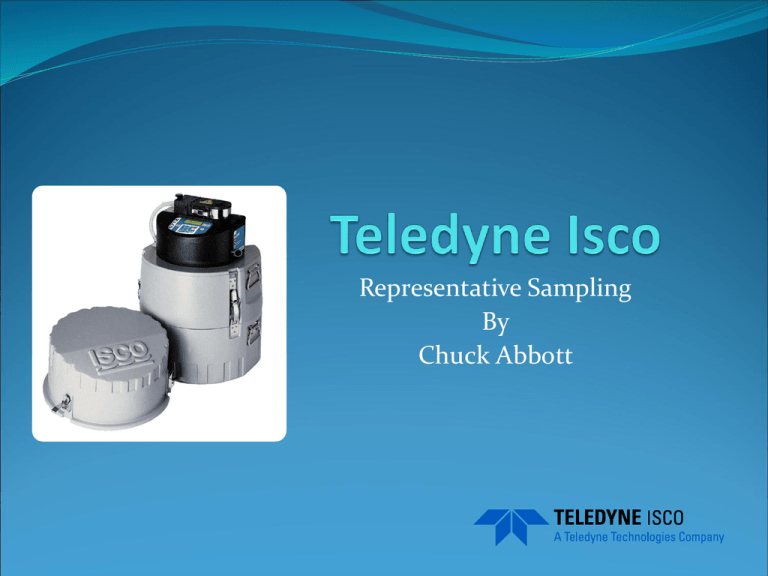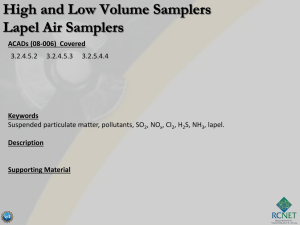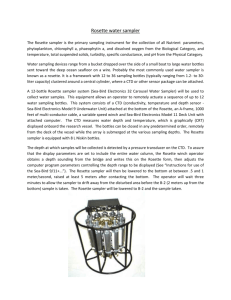Representative Sampling
advertisement

Representative Sampling By Chuck Abbott Automatic Samplers Industry Sampler Needs If sampler required, usually going to be refrigerated Permit determines type of sampling needed and frequency Sequential sampling in multiple bottles Composite samples Permit determines if any additional monitoring is needed Flow pacing for flow proportional samples pH monitoring and ability to enable sampler to take sample on high or low pH event Sequential Sampling Usually done when monitoring for specific events like slugs. Used by enforcement to check industry and determine pollutant trending Multiple bottles are used with the standard being the 24 bottle sampler. One or more samples collected in individual bottle each hour. flexible enough to take samples/bottle or multiple bottles/sample Pro Pak •Alternative to polypro bottles. •Designed to reduce bottle cleaning cost •Disposable •Sequential bags or composite bag •Directly replaces Polypro Bottles Pre-treatment Trends Pre-treatment groups are moving towards Portable Refrigerated Samplers as well as compact units such as the GLS Pre-Treatment group monitoring needs. Usually portable samplers Normally use composite but have applications that call for multibottle Need flexible program capabilities May need 2 part program Flow proportional sampling Sample enabled/ triggers based on events Stored Data Data can be stored in either 2105 or 6712 internal data logger •Data Collected via Flowlink 5.1 Important features for Industrial pre-treatment use Accurate and repeatable volume deliver Multiple bottle capabilities Accurate liquid detection system Able to take samples based on flow input or based on time or a combination of imputs Able to store sample, flow and other data that can be retrieved later Easy to maintain Bottle Options Sample Size and Frequency Minimum sample volume collected with an automatic sampler should be no less than 10 ml. Recommended size is no less than 50 ml because of liquid detector Sample volume repeatability Volume required by lab Bigger is better theory Preventative Sampler Maintenance Pump tubing replacement Suction line replacement Container replacement Diagnostic routines Volume calibration Pump Counter Counts actual revolutions Determines pump time not related to time not affected by battery Specifiable Feature! 6712 Pump Tubing Bands indicate position bands won’t slip Label for pump shows installation, direction 0.25” 0.29” Tubing Life Indicator Set for 1,000,000 counts Adjustable site conditions Maintenance tool Industrial Monitoring Integral monitoring of flow, level, pH, temperature and SDI-12 parameters Discreet bottle sampling Flexibility in programming 2 part programming Non-uniform time/ random time intervals Time enables Volume Delivery LD90 and pump counter Most accurate volumes prevents biasing in samples prevents overflows +/- 5 ml repeatability Types of Samples Distribution Composite Single Bottle Sequential Multiple Bottles Samples Per Bottle Bottles Per Sample Pacing Time Flow Event Types of Samples Composite Composite samples are small volumes of sample taken over time and placed in a large container. Composite samples can be taken in two ways, fixed volume or flow proportional Composite 5 4 3 2 1 Sequential Sampling Usually done when monitoring for specific events like slugs. Used by enforcement to check industry and determine pollutant trending Multiple bottles are used with the standard being the 24 bottle sampler. One or more samples collected in individual bottle each hour. flexible enough to take samples/bottle or multiple bottles/sample Sequential Sampling 1 2 3 4 5 6 Two Part Programming Part A Part B 2 4 6 8 3 5 7 1 2 3 4 5 6 1 1 2 3 4 5 6 7 8 9 10 11-24 Sampler Pacing Time Uniform Time- Fixed Volume Uniform Time- Volume Dependent Uniform- Flow Dependent Volume Non Uniform Time Random Time Flow Flow Paced – Time Override Trigger and Event Pacing Challenging sampling application accessories Difficult to reach locations Sampling from Pressurized lines Sampling from Flumes and Weirs Sampling in low flow conditions Batch Dischargers and how to get a representative sample. Best Sampler Location Accessibility Close to source Conserve power Maintain line velocity Reduce wear Protect suction line Minimize lift Max lift- 8.5m/28ft Auxiliary pump Safety of Personnel Security Availability of Power Source Good mixing for representative samples How to get best representative sample Use proper strainer size and type Keep intake tube short and as vertical as you can Keep sampler close to sampling point Change Pump Tubing when needed. Change intake tubing often and keep clean Strainer Placement -Flumes Strainer Placement - Weirs Strainer location here is not going to enable a representative sample to be taken. Isco Flow Thru Chamber Flow-thru chambers are available for use in low pressure (under 30 PSI) closed pipe applications. Suction Line Requirements Similar to strainer follow most stringent requirement if glass needed, use Teflon suction line clean and/or replace as needed Pressurized Line Sampling Teledyne Isco now offers pressurized sampling systems to allow sample collect from pressure lines less than 300 psi. Spa Products Specially developed products to help meet you sampling needs: •Black Vinyl Suction line •Ultra Low flow strainer •Customer support hangers such as the Pro Hanger •Remote pump option Low Flowing Pipes Low Flow Strainer 1/4” to 3/8” ¼” suction line Batch discharging and representative sampling When taking a sample from any source it must be representative of the source. Sampling a batch discharger best done with flow proportional sampling method Liquid level indicator or trigger based on level or rate of change Batch discharge example with flow paced sampling when triggered by level increase Alarming Both discreet and digital alarms available •SPA 697 for contact closure •SPA 1489 CDMA Modem •SMS Alarms Remote Communication Remote Communication through 2105 C Module as well as SPA 1489 CDMA Modem Any Questions?









